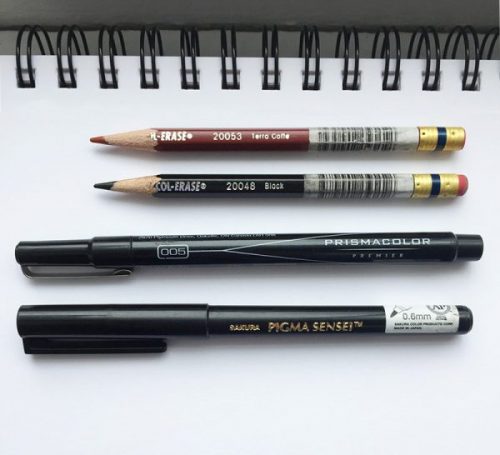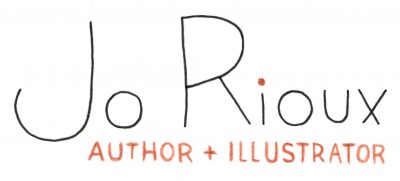Q: What tools do you use?

A: I use a mix of traditional drawing and digital painting. For my drawings I like:
- Col-erase pencils in terra cotta and black
- Prismacolor premiere pens in black size 005 or 01
- Canson mixed media drawing pads
- Good markers like pigma sensei for filling in big areas
I start by sketching with the terra cotta pencil— It’s very pale and forgiving so I can play around a lot with it and the “mistake” lines will add to the texture of the final drawing. Afterwards I pass over the sketch with the black pencil, emphasizing the outlines and adding textures. Finally I ink the drawing with a fine tipped black prismacolor pen. I don’t ink every line. I’ll often leave some areas of the drawing in pencil— like the hair for example. I find it adds an extra depth to the illustration.
Once the drawing is finished, I scan it into the computer and take it into Photoshop. I clean it up using the dodge tool, set the layer to multiply and start coloring it in layers underneath.
I’ve experimented with completely digital drawing— both in Photoshop and Procreate— and while I love the ease and versatility of it, I haven’t been able to get the same quality of drawing as the traditional method, so that’s what I’m sticking to for now!
Q: How did you find your style?
A: It took me a long time to find my own style, and that was due to some misconceptions I had about art and creativity. When I first started out, I resisted looking at other artists too closely, because I thought my style had to evolve on its own to be truly mine. I stayed stuck like that for years! I only began to make strides when I tried out different elements of style inspired by artists that I love. Some elements stuck with me, others didn’t, and in the process I found entirely new things that shaped the way I work. Experimenting was key!
On the other hand, I believe we all have a way of working that we are best suited for, and we should embrace it instead of fighting it. I naturally draw very sketchy and expressively, and I used to trace over my sketches to get a clean line. I thought it made them “polished”— what it really made them was flat and lifeless. It’s only recently that I found how to embrace my messy process and make it a part of my style.
Q: What are your inspirations?
A: I find inspiration in many different things— Nature, people, architecture, and the books I read. If something catches my eye and I want to know why, I draw it. I also find a huge source of inspiration in the illustrators I admire, like:
- Isabella Mazzanti
- Julia Sarda
- Matt Rockefeller
- Chuck Groenink
- Rebecca Green
But my style is very intuitive so I like to keep an open mind and see where my pencil takes me. Some of my best drawing have come from catching a glimpse of an unfinished sketch and seen something completely different in it!
Q: Do you have a process video?
A: Yes, I have a video of my drawing process, which I did as part of First Second Sketch School:
Q: What advice do you have for illustrators starting out?
A: Don’t fear the bad drawing! Just finish it as best you can and move on to next one. It’s more important to have a series of drawings in a similar, recognizable style than to try and shoot for that perfect drawing. And the best way to do that is to draw a lot— and specifically, to finish a lot of drawings. I’m guilty of this myself, being a serial sketcher, but my hundreds of half-done sketches don’t further my skill nearly as much as the ones I actually push through to the finished stage.
Getting a good portfolio is half the journey— then you need to let people know you’re there. Social media is a great way to get noticed by fans and professionals these days. Participate in drawing challenges on instagram and facebook to start building an audience and connect with other artists.
Q: Do you sell prints or merchandise?
A: I do! I sell prints on Etsy and merchandise on Redbubble. If there’s an illustration that you’d like to buy that you don’t see on those sites, send me an email!
Q: Do you take commissions?
A: Sadly, I don’t take any personal commissions at the moment. It’s an unfortunate side-effect of being busy with projects.
